
avintos AG
Weidenweg 17
4310 Rheinfelden
Switzerland
Contact us
Tel: +41 (0) 61 836 15 30
infoavintos.ch


Competent advice based on our many years of experience and technical expertise
Assembly of valves & automation
Assembly of hose lines (also in clean rooms)
Kitting (putting together maintenance kits)
Maintenance, testing and repair
Local warehousing
If you have a complaint, it is best to get in touch with your contact person. They will take care of your request.
You can also send an e-mail to qualityavintos.ch. Our quality department will ensure that your enquiry is processed efficiently in accordance with our guidelines.
The declaration of contamination must be completed for returns. You can download it here.
Yes, our well-trained service team provides qualified and punctual repair and maintenance work on valves and hose lines on site.
Yes, avintos can test, adjust and seal safety valves up to a set pressure of 300 barg and is SVTI-qualified.
All hose lines manufactured by avintos are subjected to a pressure test and checked for leaks. The result of the test is documented.
Yes, avintos has the technical equipment with pressure test bench and conductivity test.
Yes, depending on the type of connection, we can assemble hose lines with PFA-lined connections, or we can flare the PTFE inliner over the sealing surface to ensure chemical resistance. The advantage of flaring is that we have a full bore and no dirty edge. In addition, the flared version is cheaper.
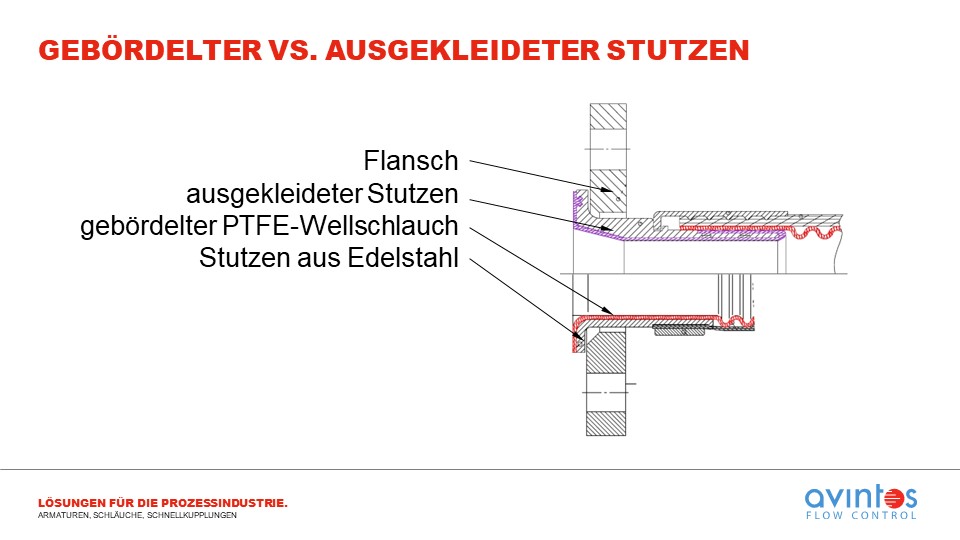
Our minimum order quantity (Minimum Order Quantity --> MOQ) is one. If you require exotic components, agreements can be made.
Yes, the delivery time of a prototype or sample always depends on the components. We work with our partners to ensure the best delivery time for prototypes.
We recommend using a manual gearbox from a nominal diameter of DN 200.
Fire-safe valves are designed in such a way that they guarantee the tightness of the closed valve for a precisely defined time even in the event of a fire and prevent the spread of fire in explosive/fire-hazardous environments. Fire-safe tests are regulated in API 607, API 6FA, BS 6755-Part 2 and ISO 10497.
Fire-safe design means that the valve is made of materials and design features intended to withstand high temperatures and prevent the spread of fire, but it has not yet been subjected to a specific fire test to confirm its performance.
Valves labelled as ‘Fire-safe certified’ have undergone thorough testing, approval and certification by an authorised third party organisation. These certifications are based on recognised standards.
Cavity pressure relief is a design measure to prevent uncontrolled pressure build-up inside the valve. Medium trapped in the valve (e.g. in the ball) can expand when heated and cause this pressure increase. An additional hole in the ball on the pressure side enables pressure equalisation with the piping system. In applications where the valve must be tight on both sides despite pressure relief, this can also be achieved by spring-loading the seat, as it is the case for the Peter Meyer ball valve as standard.
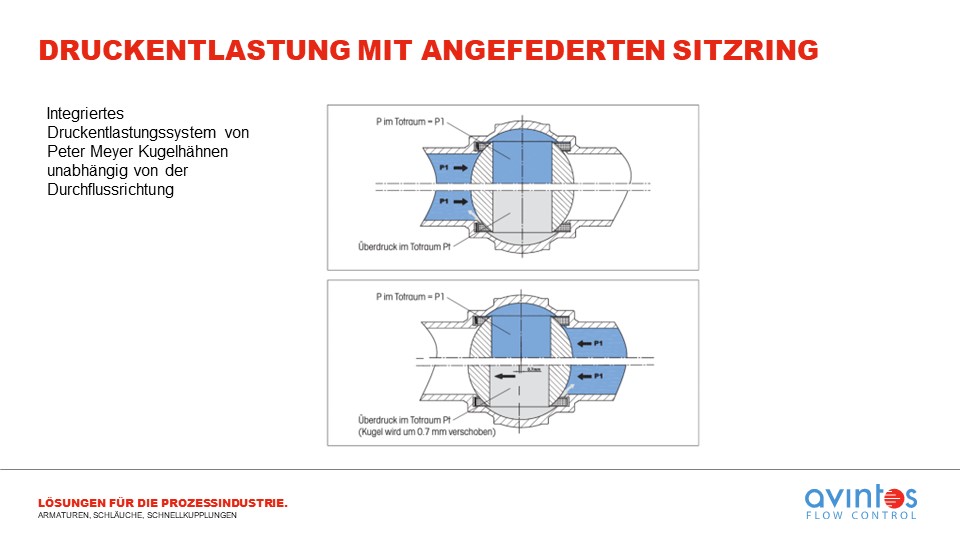
The main difference between the two is the type of shut-off element, the segmented ball valve uses a ball segment and has a relatively large through opening and is particularly suitable in difficult applications where resinous media such as adhesives and dyes, products with catalyst, powders and bulk solids are used. The solids ball valve uses a ball as the shut-off element and is more suitable for difficult applications where dry abrasive solids such as powder, ash etc. are used due to its robust design and resistance.
Oil and grease-free valves are often used in industrial applications where contamination of the process medium by oils or greases can be undesirable or even dangerous.
The nominal pressure PN is the parameter for reference purposes for standardised piping components in bar at 20°C. The pressure ratings, e.g. PN16, PN25 or PN40, indicate the maximum permissible operating pressure. For the connection, the selection of the pressure rating means that the valves and pipework must be dimensioned and designed according to the required operating pressures.
The nominal diameter DN (Diameter Nominal) is a reference size for the connection dimensions of a valve or hose in mm. The size is related to the outer or inner diameter of the connection, but it does not have to correspond to the exact dimensions of the object.
Leakage is the unwanted escape of medium either to the outside into the atmosphere or through a valve. Leaks are usually caused by defective seals and/or packing glands. The amount of permissible leakage is regulated in EN 12266-1 and is referred to as the leakage rate.
The following technical requirements must be known as a minimum for the correct selection of the valve:
Nominal size (DN) and connection variant of the valve?
Operating pressure (PN)?
Operating temperature?
Combination of maximum pressure & temperature?
Medium or composition of the medium and any special features of the medium (abrasion, cavitation, crystallisation, corrosion)?
Operating frequency?
The centric butterfly valve is the basic design of soft-seated butterfly valves. The valve shaft and sealing strip are axially centred. For higher requirements, the centric design is no longer sufficient; eccentrically arranged butterfly valves are available. Double eccentric butterfly valves are high-performance butterfly valves and have shafts that are offset from both the sealing surface and the centre line of the flow. In the triple eccentric butterfly valve, the seat cone angle forms the third eccentricity. This design is metal-to-metal sealing and enables the disc to swing out of the body seat without jamming or friction to meet the highest demands.
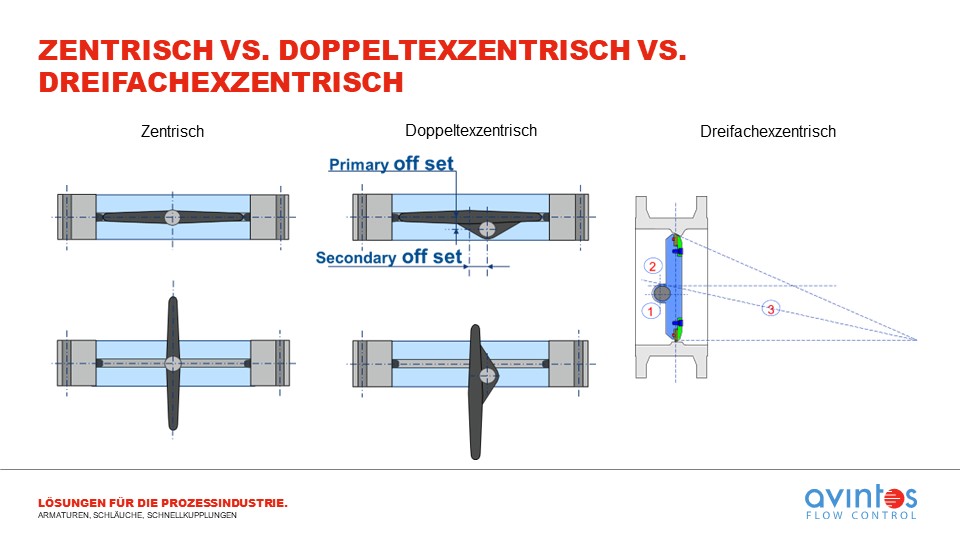
Single-acting actuators require external energy to operate the valve in one direction only. An alternative form of stored energy (e.g. a spring) acts in the opposite direction. Single-acting actuators are available as single-acting spring to close and single-acting spring to open. With double-acting actuators, external energy (e.g. compressed air) is required in both directions to operate the valve in both directions.

Pneumatic actuators can be operated either directly via a solenoid valve on the actuator, via a solenoid valve terminal or with a positioner. In the first of the two cases, the valve can only be moved to the ‘OPEN’ or ‘CLOSED’ position. The 3/2-way Namur valve is used to control single-acting actuators, while the 5/2-way Namur valve controls double-acting actuators. A positioner is required to move the valve to intermediate positions.
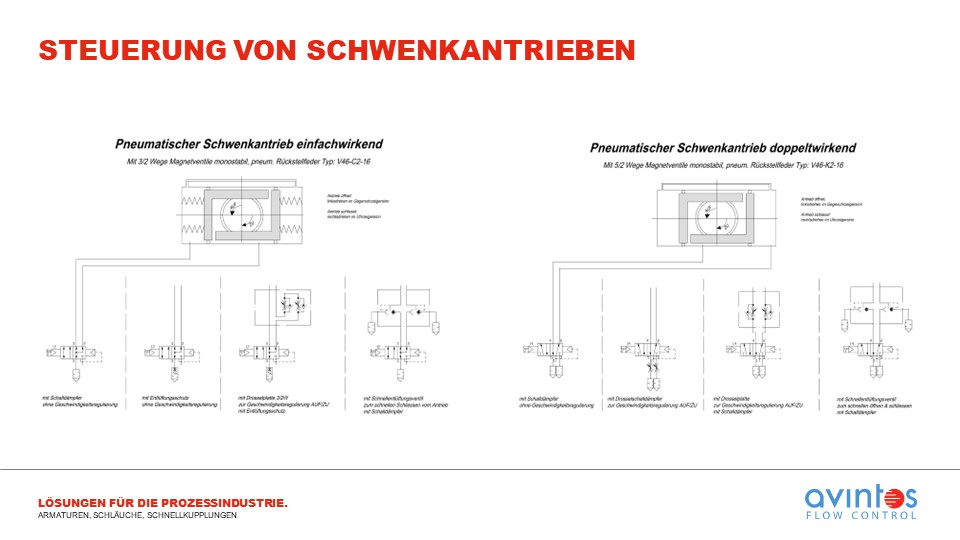
This is the predefined position of a valve that is automatically approached in the event of a failure. An example of this is a spring-closing actuator that automatically closes or opens the valve if the supply air or auxiliary power fails. This information is mandatory when ordering, as it must be taken into account when assembling the actuator.
Yes, the Biar in-line sampler can usually be installed vertically as long as certain conditions are met and the installation is carried out in accordance with the manufacturer's instructions.
However, we recommend the in-line sampler type VLB from Biar, which is specially designed for vertical piping.
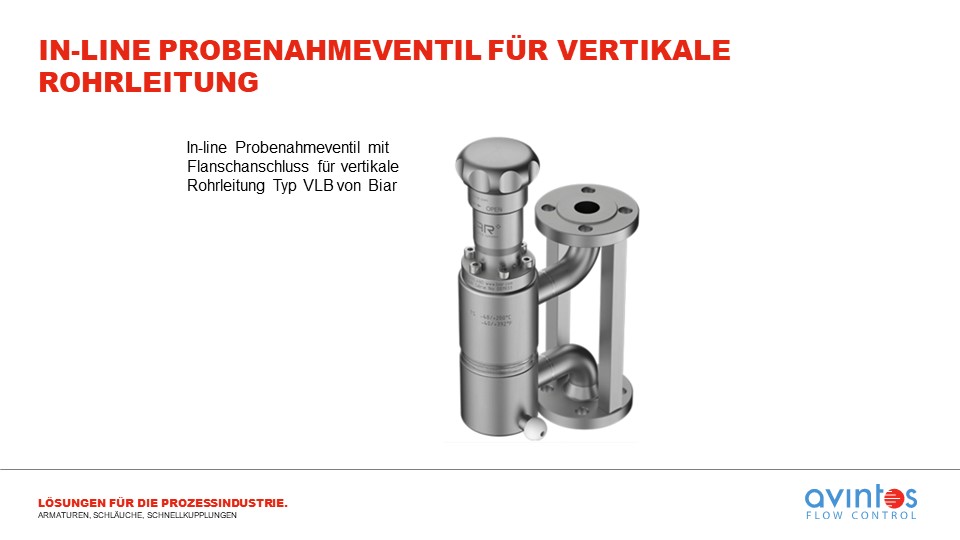
A sample that is still identical to the process medium when it arrives at the laboratory. A sample that is not contaminated or altered in any way during sampling or transport to the laboratory.
A method of taking a sample from the production facility through a closed loop that has been sterilised and kept sterile and does not come into contact with the environment during sampling.
Convoluted PTFE hoses combine optimum flexibility with easy handling, especially in the chemical, pharmaceutical, food and beverage industries. Smooth PTFE tubing is used in sterile pharmaceutical, biotechnical, food and chemical applications where good cleaning is required. The smooth PTFE liner ensures a turbulence-free flow of the medium. As a result, the pressure loss is lower than with convoluted tubing.
Our pharmaceutical hoses are made of silicone or PTFE and are produced according to strict quality specifications in clean rooms and fulfil special requirements of the pharmaceutical industry. These hoses are often used in sterile process systems because hoses made from these materials have a higher degree of purity. They are therefore used in the pharmaceutical, biotechnology and medical technology industries. All our pharmaceutical hoses are assembled and tested with connections in our clean room.
Single-use systems (SUS) are devices whose parts in contact with cells, media and products are made of plastic materials and are intended for single use only.
Overmoulding refers to moulded parts and entire systems that are manufactured using the injection moulding process. There is a major advantage over conventional, plugged systems. The moulded system consists of a single piece; there are no transitions from the hose to the connector where leaks or dead spaces could potentially occur.
We need the following information to prepare an offset of a single-use assembly:
Sketch or drawing of the assembly?
Material list (component description, part number, brand, size, length, etc.)?
Application?
Required quantities?
Type of connections?
Packaging, single or double packed?
Labelling?
Gamma irradiation / sterility?
A p-T diagram is the form of a phase diagram in which the pressure p of a system is shown against the temperature T. The set of all pairs of values of temperature and pressure result in a curve in a p,T diagram. This line is called the pressure/temperature curve.
PFA stands for perfluoroalkoxy, which belongs to the group of fluoropolymer materials and has a high chemical resistance. The main difference between PFA white and PFA black conductive lies on the one hand in the food approval and the electrical conductivity. PFA white has food approval, PFA black does not, but is electrically conductive.
Electropolishing is a surface treatment process in which a thin surface layer is slowly removed by an electrolytic reaction. The resulting surface is extremely smooth and free of crevices. This leads to less product adhesion, easier cleaning and improved corrosion resistance. Applications mainly in the biotech, pharmaceutical and food sectors.
Cleaning-in-place (CIP) is defined as the cleaning of complete systems or piping loops without dismantling or opening the equipment and with little or no manual intervention by the operator. Valves that are suitable for CIP do not have to be removed from the piping system for internal cleaning. With single-use systems, this step is not necessary, which results in lower water and energy consumption and a reduction in the CO2 footprint.
Sterilisation-in-place (SIP) is the on-site sterilisation of a production system without having to dismantle the system or parts of it.
Steam sterilisation of the process systems (SIP) takes place after CIP (Cleaning in Place) and is the optional final step in the cleaning process.
The difference is big and small at the same time. Both go through the same gamma irradiation instructions. The difference is that for sterility assurance level 10^-6 (SAL10^-6) we have to prove that the assembly falls within or can be included in our sterility programme.
avintos AG
Weidenweg 17
4310 Rheinfelden
Switzerland
Contact us
Tel: +41 (0) 61 836 15 30
infoavintos.ch